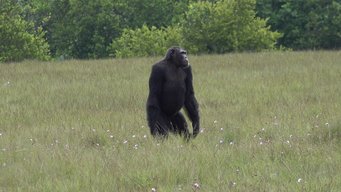First lethal attacks by chimpanzees on gorillas observed
Research team now examines impact of food competition and climate change
A research team from Osnabrück University and the Max Planck Institute for Evolutionary Anthropology in Leipzig, Germany, has, for the first time, observed lethal attacks by chimpanzees on gorillas in the wild. Whether this behavior is due to competition for food or to the decline of the rainforest's productivity caused by climate change will now be investigated in more detail.

Chimpanzees are common in East and Central Africa and live with gorillas in some areas such as the Loango National Park in Gabon. This park has also been home to the Loango Chimpanzee Project since 2005, led by Tobias Deschner, a primatologist at the Max Planck Institute for Evolutionary Anthropology, and Simone Pika, a cognitive biologist at Osnabrück University. In Loango, the researchers are observing and analyzing the behavior of around 45 chimpanzees with a special focus on group composition, social relationships, interactions with neighboring groups, hunting behavior, tool use and communicative skills. “Interactions between chimpanzees and gorillas have so far been considered as relatively relaxed”, says Simone Pika. "We have regularly observed both species interacting peacefully in foraging trees. Our colleagues from Congo even witnessed playful interactions between the two great ape species."
Lethal encounters between the chimpanzees and gorillas have so far never been documented. "Our observations provide the first evidence that the presence of chimpanzees can have a lethal impact on gorillas. We now want to investigate the factors triggering these surprisingly aggressive interactions," says Tobias Deschner.
Encounter between chimpanzees and gorillas

What exactly happened? Lara M. Southern, PhD student and first author of the study, recalls the first observation in 2019: "At first, we only noticed screams of chimpanzees and thought we were observing a typical encounter between individuals of neighboring chimpanzee communities. But then, we heard chest beats, a display characteristic for gorillas, and realized that the chimpanzees had encountered a group of five gorillas."
In the encounters, which lasted 52 and 79 minutes, the chimpanzees formed coalitions and attacked the gorillas. The two silverbacks of the two groups and the adult females defended themselves and their offspring. Both silverbacks and several adult females escaped, but two gorilla infants were separated from their mothers and were killed.
The authors from Osnabrück and Leipzig suggest several explanations for the interspecies violence observed including hunting and food competition between the species: "It could be that sharing of food resources by chimpanzees, gorillas and forest elephants in the Loango National Park results in increased competition and sometimes even in lethal interactions between the two great ape species”, says Tobias Deschner. The increased food competition may also be caused by the more recent phenomenon of climate change and a collapse in fruit availability as observed in other tropical forests in Gabon. "We are only at the beginning to understand the effects of competition on interactions between the two great ape species in Loango," says Simone Pika. "Our study shows that there is still a lot to explore and discover about our closest living relatives, and that Loango National Park with its unique mosaic habitat is a unique place to do so."












